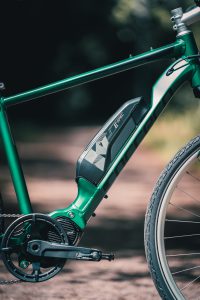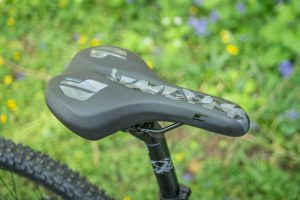Bike parts: then and now
Pedal through time as we explore how bike parts have evolved throughout the centuries. From the earliest prototypes to sleek, modern components, watch the wheels of progress turn and see how far we’ve come as cyclists!
Tyres then
Everybody knows that the wheel has been around for a long time, with the earliest evidence of its existence dating back to approximately 3500 BCE. Back then, wheels were constructed from wooden planks that worked together as a disc. They were typically used for the transportation and trade of goods via carts pulled by animals.
Before the 1860s, man-powered vehicles (or velocipedes) featured tyres made from iron bands that encircled a wooden wheel. Otherwise known as bone-shakers, it’s no surprise that these tyres offered little to no shock absorption over bumpy terrain. A slight issue considering tarmac had yet to be invented! However, in 1868, French engineer Clément Ader patented ‘rubberised wheels’ in an early attempt to improve ride comfort.
Then, in 1887, John Boyd Dunlop designed the first pneumatic (air-filled) tyre for his son, who suffered from headaches while riding his tricycle. This marked a great step for cycling comfort and efficiency.
Ever dealt with an unrecoverable flat bike tyre that needed to be replaced? Well, you can thank Édouard Michelin, who developed the detachable tyre, allowing for quick and easy replacements. This also meant that maintaining and repairing the bicycle became easier and cheaper.

Tyres today
Today, there are many different versions of bike tyres for the various ways people like to cycle. Commuters and casual riders enjoy using clincher tyres as they’re widely compatible and readily available. Mountain bikers or gravel racers tend to love tubeless tyres (officially launched in the 1990s) as they’re highly resistant to punctures and can run at lower air pressures.
Otherwise, tubular, solid (or airless), and fat tyres are other options great for urban commutes, off-road adventures, and competitive racing. Whatever their differences, modern-day Halfords tyres all come with high-quality rubber structures for strength and flexibility, advanced tread layers for grip and safety, and other optimised features for high-performance cycling.
Explore our range of tyres, however you cycle! Take a look online or pop into your local store for expert bike tyre advice and fittings.
Pedals then
The earliest form of bicycle actually didn’t even have pedals. Riders had to push their feet off the ground to propel themselves forward. However, in 1839, Kirkpatrick Macmillan revolutionised the cycling game when he added cranks and treadles. The pedals were connected to the large rear wheel via connecting rods, allowing riders to move themselves through pedalling.
Next, Philipp Fischer invented the first known pedal crank mechanism in 1853. This marked a great step towards the contemporary bike and pedal system.
By the 1880s, a bike emerged that looked a lot more similar to the kind we are familiar with today. Named the ‘safety bicycle’, it boasted two equal-sized wheels and a chain-driven rear wheel. This bike had the pedals connected to a crank at the bottom bracket for safer driving. On these safety bicycles, flat platform or ‘rat-trap’ pedals were used, allowing riders to both push and pull with each pedal stroke for extra control and power.
Pedals today
Although they were invented by Charles Hanson in the 1890s, clipless pedals took off in popularity throughout the 1980s-90s. Despite the name, these clipless pedals actually clipped in using cleats, rather than toe cages, for better walkability and convenience. This allowed pedals to truly evolve from steel to aluminium and other advanced materials like carbon fibre. With designs now reflecting purpose, pedals continue to change and grow.
With such excellent developments in the world of bike pedals, it can feel overwhelming for new riders. Check out our expert buyer’s guide on pedals here for additional support, whatever style you’re shopping for.

Saddles then
Initially, in the late 19th century, the design of bike saddles was based on horse saddles. In 1889, Arthur Lovett Garford developed the first padded bicycle seat with a leather cover, cushioning springs and adjustable tilt. This was patented in 1890 and marked a great step for the comfort and performance of cyclists.
Focusing on anatomical designs, the Christy Anatomical Saddle (1989) discussed removing the pommel (or saddle’s nose) to reduce pressure in sensitive areas, particularly focusing on the comfort of women cyclists.
Saddles today
Over time, the materials used to construct bike saddles have evolved from leather to synthetic foams, gel inserts and carbon fibre shells. Such materials typically offer greater strength and comfort for cyclists, as well as being more sustainable. As ergonomic innovation boomed throughout the 20th and 21st centuries, cut-outs, no-nose designs, and varying widths were developed to improve pressure relief, rider health and performance.

At Halfords, we offer ergonomic and comfortable saddles at a range of affordable and ambitious prices. Designed with different paddings including gel and memory foam, alongside aerodynamic tailored shapes, select your next bike saddle depending on how you choose to cycle.
Brakes then
Just like with pedals, the earliest bikes didn’t have brakes! Riders slowed themselves down by dragging their feet along the floor… seems safe, right? Well, as those early cyclists soon realised, some form of bike brake is essential for a functional, safe ride. That’s why the first bike brakes were simply levers that pushed spoons (metal or leather) onto the front tyre, although this method still had many faults.
Then, the trailblazing John Kean introduced the first front-mounted brake in 1873, offering better and more efficient stopping power. Glimpses of the modern calliper systems began to shine as Browett and Harrison patented an early calliper brake in 1887. This simply involved pressing a rubber block against the rear wheel.
By 1898, braking was actually performed by cycling backwards! Popular in the U.S. for decades, this coaster brake emerged as a primitive, but more effective stopping method. This allowed for the development of rim brakes, which pressed pads against the wheel rim, a standard throughout the 20th century.
Around the mid-20th century, calliper, Cantilever and V-brakes all became widespread, depending on the type of bike. Cantilever brakes appeared to have better mud clearance, popular with early off-road cyclists, whereas V-brakes grew popular in the 1990s due to their strong braking power.
Brakes today
Eventually, brakes began to mould into modern technologies as disc brakes were introduced to mountain bikes, improving performance and power in bad weather. Likewise, the older mechanical disc brakes that used cables, slowly become replaced by hydraulic disc brakes (that use fluid) for superior control over the bike. Today, electronic braking systems and integrated designs are being explored, so who knows what the future of bike brakes holds for our next generation of cyclists?
All we know for sure is that Halfords brakes are reliable and powerful, whatever the weather. With renowned brands like Shimano and Clarks offering disc and rim brakes, you’re bound to stop (and shop) in style.
Handlebars then
Like the rest of the bike, handlebars have also evolved from primitive steering bars to specialised and tailored designs, offering better performance and greater reliability. Starting in the early 1800s, as a basic wooden or iron bar, riders held on with both hands and could simply steer the direction in which they wanted to travel. As ‘safety bicycles’ became the standard, handlebars were generally crafted from either wood to minimise weight or steel for durability. It wasn’t until 1920 that ergonomics came into play and early drop handlebars emerged for less strenuous hand positions.
Handlebars developed depending on the type of bike that they were used for. On city and mountain bikes, riser bars were common for a more upright riding stance. Whereas for long-distance touring, butterfly bars became popularised due to their ergonomic and comfortable design. Urban riders began to favour bullhorn handlebars due to their ‘sporty’ positioning.
A ground-breaking development was made when Cinelli introduced aluminium alloy bars in the 1960s. This allowed for a lightweight and responsive performance when cycling. Aluminium handlebars paved the way for carbon fibre handlebars, which further dampened vibrations and were shaped aerodynamically.
Handlebars today

Today, there is much diversity within the different types of handlebars, offering safety, comfort and a better performance for cyclists globally. At Halfords, we’re happy to offer upgraded handlebars for perfect positioning and an optimal performance.
Now we’ve explored how bike parts started out, it’s even easier to appreciate the streamlined, advanced technologies behind each and every modern-day bike. Our bike components offer unparalleled reliability and performance, whether you ride to commute or for fun.
Why not get a professional opinion on your bike parts? We proudly offer our free 32-point bike check where our experts will inspect all key areas including, the frame, saddle, handlebars, wheels, brake system and the drivetrain. They’ll assess any wear and damage, giving you top-notch advice on upgrades or services that’ll benefit you and your bike. Simply pop in and organise your check in-store or book online. Happy riding!






